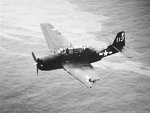oldcrowcv63
Tech Sergeant
This may not be a totally fair comparison but let's consider the relative numbers of dive bomber production over the runs of each aircraft relative to total aircraft production of fighters and bombers. This might give us an idea of the relative importance of dive bombing in each venue:
USAAF: combined A-36 + A-24 production (500+ 953)/140,000 ~ 1.04 %
USN: combined (SBD SB2C) Production ~ (5936+7140)/60,000 ~ 21.83 %
US combined Total 14,529/198,000 ~ 7.33 %
Japan combined Total (D3Y D4Y) 3,300 / 45,500 ~ 7.25 %
IJN Combined (D3Y D4Y) / 16,657 ~ 19.81 %
UK FAA Skua: (190/3,981) ~ 4.77 %
Luftwaffe Total JU-87 5009 / 74,000 ~ 6.77 %
These estimates may indicate the emphasis of dive bombing in the navies of Japan and the US but also the overall importance of dive bombing in a national priority scheme. In this the US, Japan and Germany are fairly close while the UK trails. The USAAF clearly had little relative interest in dive bombing as the normalized number of USAAF dive bombers is smaller than those of the UK considering ONLY the Skua as a representative example! I mean, in relative terms, there were fewer A-36's in the USAAF than there were Skuas in the FAA!
Very generally speaking, the USAAF was developing as a culture focused on strategic bombing and tended to regard anything not directly related to completing that mission successfully as something of a distraction. Battlefield Interdiction behind enemy lines was certainly an important mission but close air support at the front line tended to receive a greater emphasis in the USMC and USN. Of course the A-10, AC-47 and C-130 spectre gunships came out of the Vietnam experience and is now a more an integral part of the modern USAF if not necessarily seen as a prime career path. In this, I am speaking from conversations held with a relative who is retired USAF Col. Pilot with a career split between TACAIR and SAC.
What I think is an interesting question given the existence of the A-36 and its apparent quality is why none were employed by Kenney in MacArthur's Southwest Pacific Theater?
USAAF: combined A-36 + A-24 production (500+ 953)/140,000 ~ 1.04 %
USN: combined (SBD SB2C) Production ~ (5936+7140)/60,000 ~ 21.83 %
US combined Total 14,529/198,000 ~ 7.33 %
Japan combined Total (D3Y D4Y) 3,300 / 45,500 ~ 7.25 %
IJN Combined (D3Y D4Y) / 16,657 ~ 19.81 %
UK FAA Skua: (190/3,981) ~ 4.77 %
Luftwaffe Total JU-87 5009 / 74,000 ~ 6.77 %
These estimates may indicate the emphasis of dive bombing in the navies of Japan and the US but also the overall importance of dive bombing in a national priority scheme. In this the US, Japan and Germany are fairly close while the UK trails. The USAAF clearly had little relative interest in dive bombing as the normalized number of USAAF dive bombers is smaller than those of the UK considering ONLY the Skua as a representative example! I mean, in relative terms, there were fewer A-36's in the USAAF than there were Skuas in the FAA!
Very generally speaking, the USAAF was developing as a culture focused on strategic bombing and tended to regard anything not directly related to completing that mission successfully as something of a distraction. Battlefield Interdiction behind enemy lines was certainly an important mission but close air support at the front line tended to receive a greater emphasis in the USMC and USN. Of course the A-10, AC-47 and C-130 spectre gunships came out of the Vietnam experience and is now a more an integral part of the modern USAF if not necessarily seen as a prime career path. In this, I am speaking from conversations held with a relative who is retired USAF Col. Pilot with a career split between TACAIR and SAC.
What I think is an interesting question given the existence of the A-36 and its apparent quality is why none were employed by Kenney in MacArthur's Southwest Pacific Theater?
Last edited:

